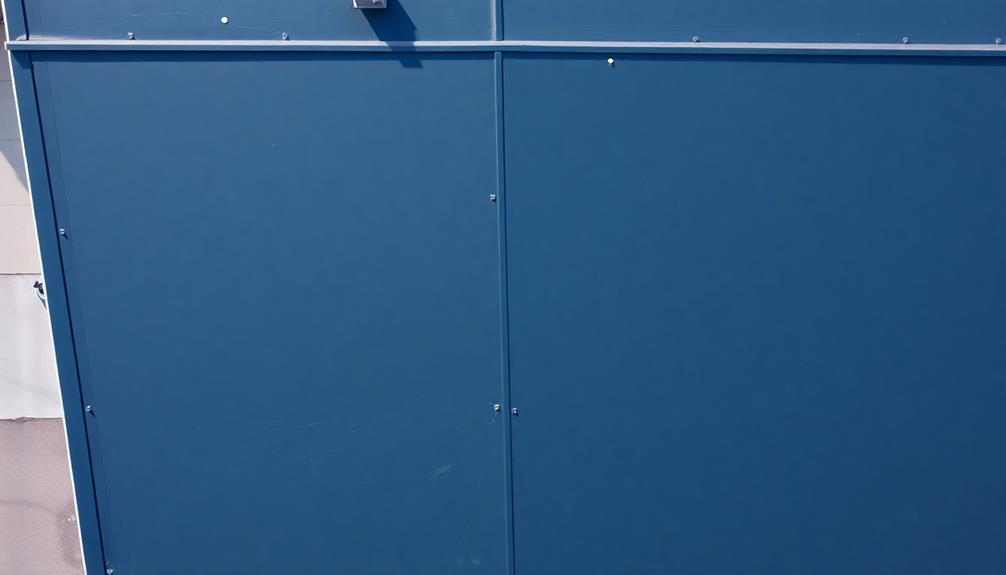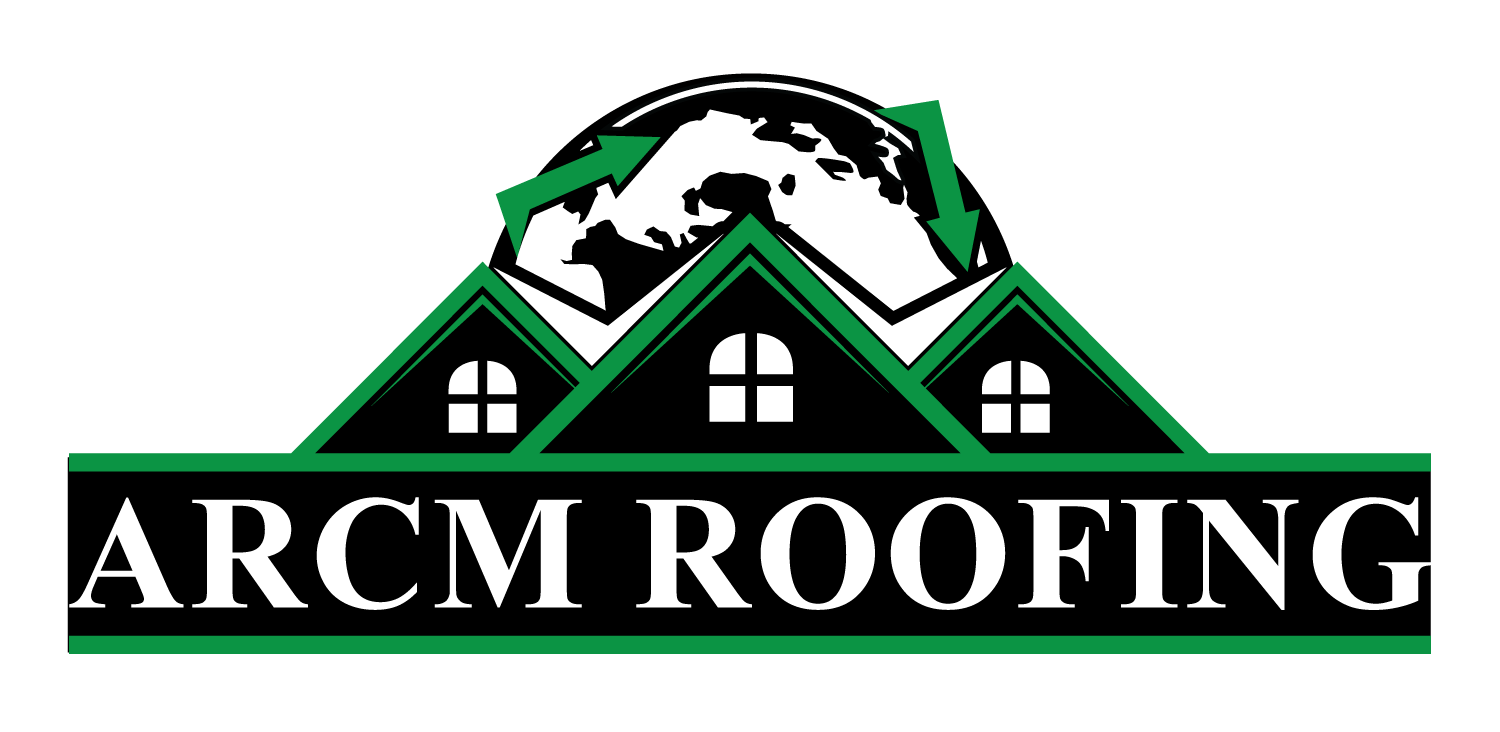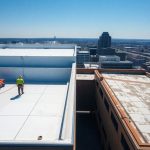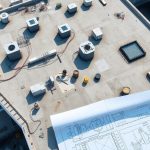EPDM roofing is an ideal choice for businesses due to its durability and adaptability in various climates. Composed of ethylene, propylene, and a diene monomer, this membrane resists ozone, UV radiation, and extreme weather, ensuring a reliable and long-lasting roof. The installation process requires meticulous substrate preparation and precise placement, using adhesives compatible with the roofing material. Such installations are crafted by skilled professionals utilizing specialized tools to guarantee seamless coverage. Routine inspections are essential for maintaining performance, and Colorado businesses specifically benefit from tailored services to cope with local climatic challenges. Explore the detailed advantages and processes of EPDM roofing systems.
Roofing Highlights
- EPDM roofing is highly durable and can last over three decades, even in harsh weather conditions.
- It offers cost-effective installation and maintenance, reducing long-term roofing expenses for businesses.
- EPDM's flexibility allows it to accommodate structural movements, avoiding cracks and leaks.
- The material provides excellent thermal insulation, contributing to energy efficiency and reduced operating costs.
- EPDM roofing is environmentally friendly, made from recyclable materials, and reduces landfill waste at its end of life.
EPDM Roofing Explained

Our business is dedicated to providing excellent EPDM roofing solutions tailored to meet the unique needs of our commercial clients. Understanding the complexities involved in roofing installations and maintenance, we utilize the latest industry standards and technologies to guarantee durable and weather-resistant roofing systems.
Our expert team conducts a thorough assessment to determine the most effective EPDM application, thereby enhancing energy efficiency and reducing long-term operational costs for businesses. Additionally, we offer commercial roofing services that handle repairs, full replacements, and any job size to ensure comprehensive coverage.
Leveraging trusted industry partnerships, competitive pricing, and a commitment to outstanding customer service, we aspire to deliver unparalleled quality, ensuring our clients benefit from reliable and sustainable roofing that protects their assets for years to come.
Material Composition Overview
Emerging as a durable and versatile choice for commercial roofs, EPDM (Ethylene Propylene Diene Monomer) rubber roofing boasts a unique material composition that enhances its performance and longevity. EPDM is primarily comprised of ethylene and propylene, derived from oil and natural gas, expertly polymerized to form a resilient and highly elastic synthetic rubber. To further augment its qualities, the addition of diene in the polymer chain facilitates cross-linking during the vulcanization process, granting EPDM exceptional flexibility under various temperature ranges. This adaptability empowers the roofing material to withstand thermal expansion and contraction, imperative for long-term durability.
EPDM's material composition inherently resists ozone, ultraviolet radiation, and extreme weather conditions, factors often detrimental to lesser roofing alternatives. Additionally, its relatively inert chemical makeup contributes to a stable surface that avoids cracking or degradation over time. In commercial applications, embrace the stability and peace of mind that this rubber roofing solution offers, driving a sense of community among your business operations. By leveraging its remarkable environmental durability, EPDM roofing assures reduced maintenance requirements and cost-effectiveness, establishing itself as a harmonious fit within the broader context of sustainable and efficient building solutions.
Installation Process Insights
The installation of EPDM roofing, a crucial phase in maximizing its durability and efficiency, requires precision and expertise. An integral part of the process is surface preparation, confirming the roofing substrate is clean and smooth, free from sharp objects or debris that might impede the adhesion of the membrane.
Bonding involves the application of an adhesive layer, which demands careful compatibility checks to prevent premature deterioration. The EPDM membrane, with its characteristically robust material, is meticulously unrolled and laid out without tension or wrinkles, reinforcing the seamless barrier it forms against environmental challenges.
Attention to detail is paramount, especially at roof edges and penetrations, such as chimneys or ventilation systems. These areas are nuanced focal points that necessitate additional sealing techniques, often using a combination of tape and liquid adhesives to guarantee waterproofing.
Skilled professionals employ industry-standard tools, incorporating rollers and squeegees, to eliminate air entrapments that could compromise insulation and longevity. The installation process evolves with innovation, necessitating collaboration, understanding, and a commitment to high standards. Hence, choosing experienced installers is critical, as they confirm that the potential of the EPDM roofing system is fully realized over its lifespan.
Longevity And Maintenance
Many factors contribute to the exceptional longevity of EPDM roofing systems, making them a preferred choice for commercial buildings. This synthetic rubber membrane boasts a remarkable ability to withstand extreme weather conditions, including prolonged exposure to ultraviolet (UV) radiation, ozone, and thermal fluctuations. Its flexibility and elasticity enable it to accommodate structural movements and thermal contraction, greatly reducing the risk of damage. Additionally, EPDM's inherent resistance to hail and wind uplift further assures its durability across diverse climates.
Maintenance of EPDM roofing systems is strikingly straightforward, enhancing their appeal among businesses seeking reliable and cost-effective solutions. Routine inspections, ideally twice a year, are critical in identifying potential issues early. This proactive approach includes checking for debris accumulation, punctures, or seam separations which can compromise the membrane's integrity if left unaddressed. Periodic cleaning to remove dirt and environmental contaminants can extend the roof's lifespan considerably.
Professional maintenance services also guarantee that any necessary repairs are conducted meticulously, preserving the EPDM's performance. Additionally, a well-maintained EPDM roof presents an opportunity to boost energy efficiency by reflecting solar heat, reducing cooling costs. Businesses investing in EPDM gain not only a durable roofing solution but also a trusted partner in sustaining their property's future resilience.
Benefits

EPDM roofing stands out as a premier choice for businesses due to its exceptional durability and guarantee of longevity, allowing enterprises to invest in a robust roofing system that withstands diverse weather conditions.
For companies in the Denver, Colorado metro area, our highly-skilled and professional team safeguards that the installation is seamless and the end results meet the highest standards of quality.
Its cost-effectiveness further enhances its appeal, providing a pragmatic solution that minimizes long-term expenses associated with maintenance and repairs.
Additionally, EPDM contributes tremendously to environmental efforts by reducing energy consumption and decreasing carbon footprints, making it a sustainable option for environmentally conscious businesses.
Durability and Longevity Assurance
When considering roofing materials for commercial properties, the durability and longevity of EPDM (ethylene propylene diene terpolymer) stands out amongst alternatives. EPDM roofing systems have earned a reputation for their remarkable ability to withstand the rigors of diverse environmental conditions, making them a prudent choice for businesses seeking reliable protection for their assets.
The inherent flexibility of EPDM allows it to adapt to varying temperatures, from blistering summer heat to frigid winter cold, without compromising its integrity, consequently ensuring that the roofing membrane retains its waterproof capabilities over time.
EPDM's composition contributes to its resilience against ultraviolet radiation and ozone exposure, factors that commonly degrade other roofing materials. This resistance extensively extends the material's service life, offering businesses a dependable roofing solution expected to last in excess of three decades with minimal maintenance.
Additionally, EPDM is resistant to thermal shock, so it does not easily crack or split during temperature fluctuations or extreme weather events. These characteristics, combined with its simplicity of installation and compatibility with a wide range of building designs, position EPDM as a premier choice, assuring business owners of both durability and longevity that fosters peace of mind.
Cost-Effective Roofing Solution
Beyond the unmatched durability and longevity of EPDM, its cost-effectiveness further elevates its appeal for commercial applications. This rubber roofing membrane offers an economical solution that aligns with budgetary constraints frequently encountered in business environments. Initial installation costs for EPDM are markedly lower compared to other roofing systems, allowing companies to allocate resources more effectively across infrastructure or operational expansions.
In addition to the initial savings, EPDM requires minimal maintenance, reducing ongoing expenses. Its resistance to UV rays, thermal shocks, and severe weather conditions minimizes the need for frequent repairs, thereby translating into substantial long-term savings. The straightforward repair process further curtails costs, as most damages can be easily remedied without specialized equipment or labor, reinforcing its financial viability.
Moreover, EPDM's adaptability fits varying structural designs, making it a versatile choice across different commercial sectors. This adaptability does not equate to additional costs, as its flexibility inherently reduces material waste during installation. For businesses cautious about overhead expenses, EPDM represents a sound investment, promising reliability alongside tangible economic benefits. The practical cost-efficiency of EPDM guarantees its position as a favored choice among businesses intent on achieving operational sustainability without compromising on quality.
Environmental Impact Reduction
A significant advantage of adopting EPDM roofing in commercial sectors is its positive impact on environmental sustainability. With a focus on reducing ecological footprints, businesses increasingly embrace EPDM roofs, recognizing the material's long-term environmental benefits.
EPDM, or Ethylene Propylene Diene Monomer, is a synthetic rubber membrane that offers excellent thermal insulation, reducing energy consumption and thereby lowering greenhouse gas emissions. This reduction in energy use aligns with green building standards, promoting an eco-friendly business environment and encouraging community cohesion amongst environmentally conscious enterprises.
The manufacturing process of EPDM itself contributes to its eco-friendly reputation. EPDM roofs are predominantly chiefly constructed from recycled materials, ensuring a prolonged service life. Additionally, these roofs are fully recyclable at the end of their lifespan, reducing landfill waste. This cradle-to-cradle approach not only underlines the material's sustainable qualities but also fosters a shared commitment to resource efficiency within the business community.
Moreover, the dark color of EPDM roofs facilitates efficient heat absorption, potentially decreasing the urban heat island effect prevalent in industrial regions. By opting for EPDM, businesses echo a collective resonance towards eco-conscious practices, reinforcing their role as responsible stewards of the environment.
Installation Process Insights

The installation of EPDM roofing is a highly structured process that demands careful attention to detail, beginning with meticulous preparation and surface requirements to safeguard a smooth and durable application. The application of adhesives must be performed with precision to avoid future maintenance challenges, while sealing and finishing techniques are critical for protecting roof integrity against harsh weather conditions. Below is a table highlighting essential components of the installation process, providing a quick reference for these crucial steps.
| Installation Aspect | Key Considerations |
|---|---|
| Preparation Requirements | Surface cleanliness and debris removal |
| Surface Requirements | Maintain smooth and dry surfaces |
| Adhesive Application | Correct adhesive choice and coverage |
| Sealing Techniques | Proper seam sealing for waterproofing |
| Finishing Tips | Trim and inspection for durability |
Preparation and Surface Requirements
Proper preparation is the cornerstone of a successful EPDM roofing installation for businesses. Before commencing the installation journey, one must ensure that the roof surface is in optimal condition to receive the EPDM membrane. Start by thoroughly evaluating the roof's structural integrity, addressing any repairs that deficiencies demand.
The surface must be smooth, clean, and free from debris, oils, or sharp objects that could compromise the membrane's effectiveness. For achieving an ideal surface, remove loose material and old roofing remnants, emphasizing the need for attention to detail. This ensures that all potential hindrances to adhesion are eradicated.
The existing substrate should be firm and secure, neither exhibiting significant movement nor vulnerability to damage. If moisture is detected, this must be rectified prior to installation, as moisture can severely undermine the longevity and performance of EPDM membranes.
Furthermore, businesses should ensure compatibility between surface materials and the intended EPDM roofing system. Specifying materials that align with EPDM requirements fosters cohesion in appearance and function, enabling seamless integration. Equipping your team with the right tools, protective gear, and knowledge will empower a meticulous approach, fortifying the foundation for a robust, enduring roofing solution.
Adhesive Application Techniques
When applying adhesive in EPDM roofing installations, understanding the technique's intricacies is essential for success. The bond between the EPDM membrane and the substrate relies on precise application methods to guarantee durability and weather resistance.
Start by selecting an adhesive compatible with the specific EPDM product and substrate material. Apply the adhesive evenly over the substrate using a suitable roller or brush, avoiding gaps and making sure of full coverage. Timing is vital; allow the adhesive to become tacky before proceeding to lay the membrane, as premature placement can lead to inadequate bonding or air entrapment.
Preventing wrinkles and ensuring proper alignment requires careful handling of the EPDM sheet. Begin by positioning the membrane on the prepared surface without tension, gradually unrolling and pressing it into the adhesive. Utilize a weighted roller to firmly press the membrane, making sure of a good bond and eliminating any trapped air bubbles that could compromise the installation. Make sure the edges are firmly adhered, as these are most susceptible to wind and water penetration.
Following these techniques fosters a reliable and long-lasting roof system, ultimately contributing to the sense of community among professionals working toward achieving excellence in the roofing industry.
Sealing and Finishing Tips
Safeguarding a secure and weather-tight seal is essential in the final stages of EPDM roofing installation. Successfully sealing an EPDM roof involves meticulous attention to detail in both technique and material selection, pivotal in preserving the longevity and efficiency of the roofing system.
Start by thoroughly cleaning the rubber membrane and any contact surfaces, which guarantees optimal adhesion and prevents future leaks. Using primer tailored for EPDM materials enhances bond strength and creates a robust interface for seam tapes.
Once cleaned and primed, carefully apply seam tape or adhesive, ensuring it aligns perfectly with the membrane's edges. This requires precise pressure application to eliminate air bubbles and wrinkles, both of which can compromise the integrity of the seal. Utilize professional-grade rollers to guarantee uniform contact across the entire surface.
For overlapping seams, sealant application is pivotal. A high-quality EPDM sealant adds an additional layer of moisture protection. Inspecting the edges, corners, and any penetration points—such as vents or HVAC units—guarantees no vulnerabilities are left unchecked. Reinforcing these areas with additional sealing components as necessary ensures an airtight finish. This attention to every detail fosters an environment where shared goals of durability and protection are deeply valued.
Connect With Us
Ready to enhance the durability and efficiency of your business's roofing with EPDM? Our team of experts is here to help you every step of the way.
Whether you have questions or are ready to start your EPDM roofing project, don't hesitate to reach out. Call us today at (303) 306-8384 and contact ARCM Information.
Let's discuss how EPDM roofing can benefit your business. Your satisfaction is our top priority, so connect with us now and take the first step toward a superior roofing solution!
Roofing FAQ
What Is the Lifespan of EPDM Roofing for Commercial Buildings?
The lifespan of EPDM roofing generally ranges from 25 to 30 years, contingent upon factors such as proper installation and maintenance. Businesses investing in EPDM benefit from both long-term durability and cost-effectiveness, reinforcing community values of sustainability and reliability.
How Does EPDM Roofing Compare With Other Commercial Roofing Materials in Terms of Cost?
Cost comparison among commercial roofing options reveals that EPDM is generally more affordable. Its cost-effectiveness, combined with durability, makes EPDM a popular choice. However, individual preferences and needs should guide the final selection of roofing material.
Can EPDM Roofing Be Installed During Winter Months?
The installation of roofing systems during winter requires careful planning. EPDM roofing can typically be installed in colder months utilizing specialized adhesives resilient to low temperatures, ensuring seamless adherence and functionality, thereby meeting the community's desire for durable, year-round solutions.
What Maintenance Is Required for EPDM Roofing to Ensure Durability?
To guarantee durability, regular inspections, prompt repairs of damages, removal of debris, and cleaning of drains are essential. Additionally, applying a protective sealant can enhance longevity and performance, fostering reliability within the roofing community.
Are There Color Options Available for EPDM Roofing Beyond Black or White?
Expanding color options for roofing membranes increases aesthetic flexibility and alignment with organizational branding. Industry advancements now offer EPDM roofing in various colors, including gray, tan, and custom hues, enhancing both functionality and visual integration.



